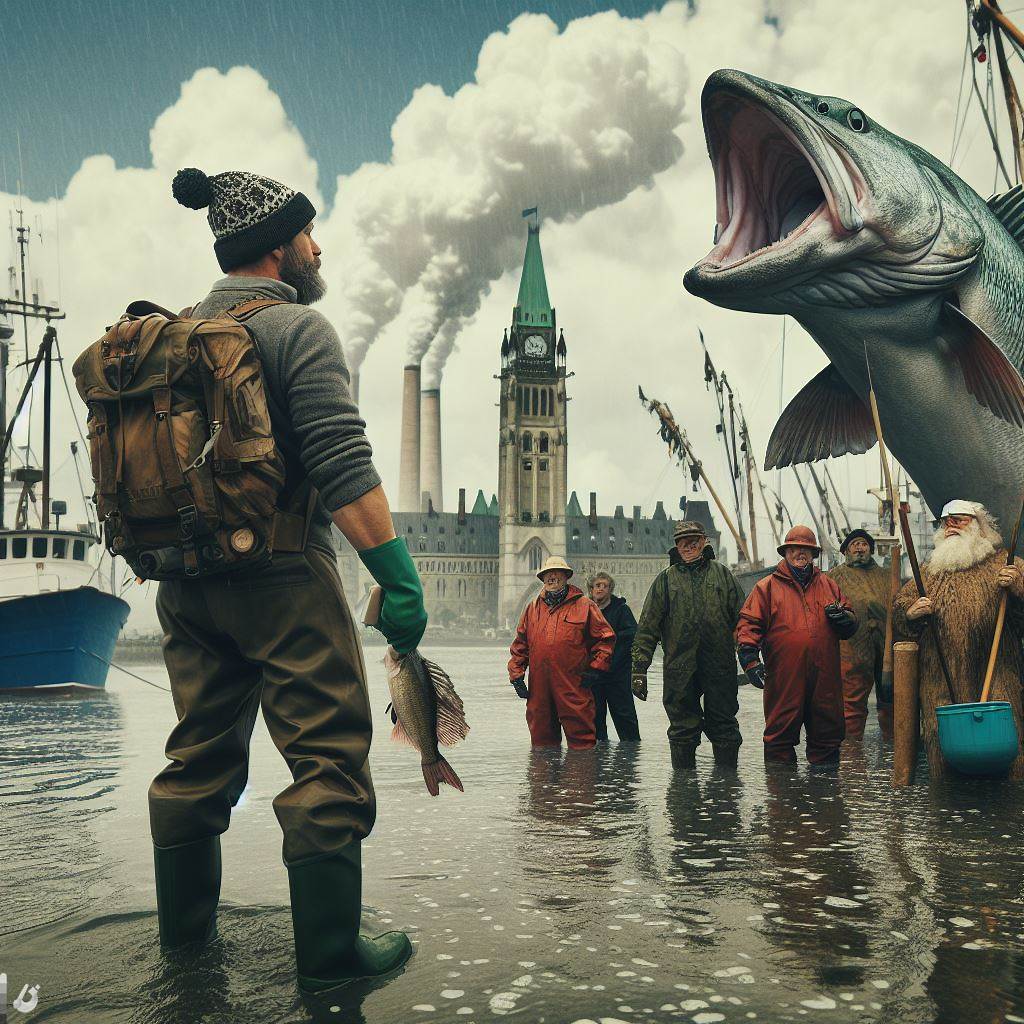Introduction
Dive into the dynamic trends shaping Canada’s fishing industry.
Explore the latest developments, including:
- Sustainable practices for conservation.
- Technological advancements enhancing fishing efficiency.
- Market shifts reflecting consumer preferences.
Discover how these trends are reshaping the landscape of Canadian waters, ensuring a sustainable and vibrant fishing future.
Brief history of the fishing industry in Canada
Early development and impact on Indigenous communities
The fishing industry in Canada has a long and fascinating history, dating back thousands of years.
Indigenous communities have relied on fishing as a crucial source of food and livelihood, shaping their way of life.
The Indigenous people were the earliest contributors to the Canadian fishing industry, employing traditional techniques and sustainable practices.
They had a deep respect for nature and ensured the balance between humans and marine ecosystems.
However, with the arrival of European settlers, the fishing industry underwent significant changes.
The Indigenous communities faced displacement and marginalization.
European fishing methods were introduced, leading to overfishing and depletion of fish stocks, impacting the communities heavily reliant on fishing.
European arrival and expansion of commercial fishing
The 16th century marked the arrival of Europeans in Canada and the subsequent expansion of commercial fishing.
European settlers recognized the abundance of marine resources, contributing to the rapid growth of the fishing industry.
With the development of new technologies and fishing practices, commercial fishing became more efficient.
European fishing fleets grew, and the demand for fish increased, leading to significant economic growth for European settlers.
The introduction of fishing villages and processing plants transformed coastal communities.
They became hubs for fish processing and export, creating employment opportunities for the local population.
While the industry brought wealth to some, it also had detrimental effects.
Overfishing and unsustainable practices caused a decline in fish stocks, affecting not only the marine ecosystem but also the livelihoods of Indigenous and non-Indigenous communities alike.
Modern regulations and quotas
In response to the declining fish stocks and need for conservation, modern regulations and quotas were implemented by the Canadian government.
These aim to ensure sustainable fishing practices and protect the marine ecosystem.
Regulations include restrictions on fishing gear, catch limits, and closed seasons.
Quotas are allocated to fishing companies and individuals, limiting the amount of fish they can harvest.
These measures prevent overfishing and promote responsible fishing practices.
The government works closely with Indigenous communities to incorporate their traditional knowledge and practices into modern fishing regulations.
This partnership respects their rights and ensures a more sustainable future for both the industry and the communities.
Unlock Your Career Potential
Visualize a clear path to success with our tailored Career Consulting service. Personalized insights in just 1-3 days.
Get StartedEducation and awareness programs play a crucial role in promoting responsible fishing practices among all stakeholders.
Collaborative efforts between government, scientists, industry, and communities are essential in safeguarding the fishing industry’s future.
The fishing industry in Canada has come a long way from its early roots with Indigenous communities to its current state of regulation and conservation.
By recognizing the past and employing sustainable approaches, the industry can thrive while preserving the marine ecosystem for future generations.
Read: Sustainable Practices in Canadian Farms
Current state of the fishing industry in Canada
Economic importance and contribution to GDP
- The fishing industry in Canada plays a crucial role in the country’s economy.
- It contributes significantly to the nation’s Gross Domestic Product (GDP).
- Revenue generated from fishing activities contributes to economic growth and development.
- Both commercial and recreational fishing activities contribute to the overall economic importance.
- The fishing industry supports several related sectors, such as seafood processing and export.
- It attracts domestic and international investments, creating a positive economic impact.
- Overall, the fishing industry is a vital contributor to Canada’s economy and GDP growth.
Employment opportunities and workforce demographics
- The fishing industry provides employment opportunities for several Canadians, particularly in coastal regions.
- Various job roles within the fishing industry include fishermen, deckhands, processors, and aquaculture workers.
- Coastal communities heavily rely on the fishing industry for livelihood and employment.
- However, the workforce demographics in the fishing industry have experienced shifts in recent years.
- An aging workforce and a decline in new entrants pose challenges for the industry.
- Efforts are being made to attract younger generations to pursue careers in the fishing sector.
- Training programs and incentives are being offered to encourage workforce development.
- Diversity and inclusivity within the industry are also areas of focus for future sustainability.
Key species and regions of fishing activities
- Canada is blessed with vast and diverse marine ecosystems, supporting a wide range of fish species.
- Key species in Canadian waters include Atlantic cod, Atlantic salmon, halibut, herring, and shellfish.
- Each region in Canada has its own unique fishing activities, influenced by geographical factors.
- Atlantic Canada is famous for its cod fishery, while British Columbia is known for salmon and halibut.
- The Great Lakes region also supports various fishing activities, including sport fishing.
- Northern regions of Canada are known for their Arctic char and other cold-water species.
- Fishing activities are regulated under provincial and federal laws to ensure sustainability and conservation.
- Efforts are made to prevent overfishing and protect endangered species through quotas and fishing restrictions.
Basically, the fishing industry in Canada holds significant economic importance, contributing to the GDP and offering employment opportunities.
Key species and regions play a vital role in the fishing activities carried out in Canadian waters.
However, the industry also faces challenges with an aging workforce and the need to attract younger generations.
Sustainability and conservation efforts are crucial to maintain the industry’s long-term viability.
Read: Navigating Fishing Regulations in Canada
Environmental challenges and sustainability efforts
Overfishing and its consequences
Overfishing is a major challenge facing the fishing industry in Canadian waters.
It occurs when fish are harvested at a rate higher than they can reproduce and replenish their population.
This can have severe consequences, not only for the fish species but also for the entire marine ecosystem.
When a specific fish population is overfished, it can disrupt the natural balance, leading to the decline of other species that rely on it for food.
Overfishing can also lead to economic and social consequences.
As fish populations decline, fishermen are forced to travel longer distances and spend more time at sea to catch smaller quantities of fish.
This increases their costs and reduces their profitability, making it harder for them to sustain their livelihoods.
In addition, overfishing can lead to the collapse of fish stocks, affecting not only the fishing industry but also the communities that depend on it.
Conservation initiatives and fishing restrictions
To address the issue of overfishing and ensure the long-term sustainability of Canadian fisheries, various conservation initiatives and fishing restrictions have been implemented.
These measures aim to regulate fishing activities, protect vulnerable species, and rebuild depleted fish populations.
One such initiative is the implementation of quotas and catch limits.
These restrictions ensure that only a certain number of fish can be caught in a specific area within a particular time frame.
By establishing these limits, authorities can prevent overfishing and allow fish populations to recover.
Another conservation measure is the establishment of marine protected areas (MPAs).
MPAs are designated areas where fishing is either prohibited or limited to specific methods and seasons.
These areas serve as sanctuaries for fish species to reproduce and grow, contributing to the overall sustainability of the marine environment.
Additionally, government and industry stakeholders have collaborated to improve fishing practices and promote sustainable fishing methods.
This includes the adoption of selective fishing techniques that target specific fish species while avoiding the capture of non-target species.
By reducing bycatch (the unintentional capture of non-target species), these practices help minimize the negative impact on marine biodiversity.
Impact of climate change on Canadian fisheries
Climate change is another significant environmental challenge that has the potential to profoundly affect Canadian fisheries.
Rising sea temperatures, ocean acidification, and changing currents can alter the distribution and behavior of fish species, impacting their availability and abundance.
Warmer waters can cause certain fish species to move, leading to shifts in fishing grounds and potential conflicts between different fishing fleets.
This can result in economic losses and challenges for fishermen who may have to adapt to new fishing grounds.
Furthermore, changes in ocean chemistry due to increased carbon dioxide absorption can affect the reproductive success and survival rates of fish larvae and other marine organisms, further impacting fish populations.
To mitigate the effects of climate change, it is crucial for the fishing industry to adapt and implement sustainable practices.
This may include adjusting fishing seasons, adopting new gear technologies, and diversifying target species to account for the changing marine environment.
Additionally, strengthening international cooperation and sharing scientific research can help identify and respond to climate-related challenges in Canadian waters.
Essentially, the fishing industry in Canadian waters faces significant environmental challenges.
Overfishing, conservation efforts, and climate change all have profound impacts on the sustainability and long-term viability of fisheries.
By implementing conservation initiatives, fishing restrictions, and adapting to climate change, the industry can strive towards maintaining healthy fish populations and ensuring the livelihoods of fishermen and the communities that depend on them.
Read: Modern Equipment in Canadian Logging

Technological advancements in the fishing industry
In recent years, the fishing industry in Canada has seen significant advancements in technology, revolutionizing the way fishermen operate and impacting the overall sustainability of fishing practices.
These technological innovations have mainly focused on improving fishing gear and vessel technology, with both benefits and drawbacks.
Improvements in fishing gear and vessel technology
One of the key improvements in the fishing industry can be seen in the advancements made in fishing gear.
Traditional fishing gear has been enhanced to become more efficient and sustainable.
For instance, the introduction of nets with selective meshes has contributed to reduced bycatch, allowing fishermen to catch their target species while minimizing harm to other marine life.
Furthermore, the development of more durable and resistant materials for fishing gear has increased their longevity and decreased the need for frequent replacements.
This not only reduces costs for fishermen but also minimizes the impact on the environment by reducing waste generated from discarded gear.
Another area where technology has made significant contributions is vessel technology.
Modern fishing vessels are now equipped with advanced navigational systems, enabling fishermen to locate schools of fish more accurately.
This not only improves catch efficiency but also reduces fuel consumption and, consequently, carbon emissions, leading to a more environmentally friendly fishing industry.
Benefits and drawbacks of technological innovations
However, technological advancements in the fishing industry also come with their set of drawbacks.
One of the primary concerns is the potential for overfishing due to increased efficiency in catching fish.
With improved gear and vessel technology, fishermen are now able to catch larger quantities of fish in shorter periods.
Without proper management and regulations, this could lead to the depletion of fish stocks and the disruption of marine ecosystems.
Moreover, there is a concern among traditional fishermen that these advancements may lead to job losses.
As technology continues to advance, automation has become more prevalent in the fishing industry.
This has the potential to replace human labor, reducing employment opportunities for fishermen who rely on traditional fishing methods.
Role of scientific research in sustainable fishing practices
Nevertheless, the role of scientific research in the development of sustainable fishing practices cannot be overstated.
Scientific research provides critical data on fish populations, migration patterns, and the overall health of marine ecosystems.
This information is vital for creating effective policies and regulations to ensure the long-term sustainability of the fishing industry.
Scientists are also working to develop innovative solutions to mitigate the negative impacts of technology on the fishing industry.
This includes the integration of technologies such as artificial intelligence and machine learning to create more efficient and sustainable fishing practices.
In a nutshell, technological advancements have greatly influenced the fishing industry in Canadian waters.
Improvements in fishing gear and vessel technology have resulted in more efficient and sustainable practices.
However, careful management and regulations are necessary to prevent overfishing and protect marine ecosystems.
Scientific research and innovation continue to play a crucial role in achieving sustainable fishing practices for the future.
Read: Canadian Farming: Small vs. Large Scale
Market trends and international trade
Domestic consumption and export patterns
The fishing industry in Canada has experienced significant changes in market trends and international trade in recent years.
One important aspect to consider is domestic consumption, which plays a crucial role in the sustainability of the industry.
Consumers in Canada are becoming increasingly conscious of the environmental and health impacts of seafood consumption.
This has led to a growing demand for sustainably sourced and traceable seafood products, creating new market opportunities.
In terms of export patterns, Canada has traditionally been a major exporter of seafood products to various international markets.
Canadian fish and seafood products are highly regarded for their quality and freshness, making them sought-after commodities worldwide.
The export market has been essential for the growth and profitability of the Canadian fishing industry.
Trading partners and main export markets
Canada has established strong trading relationships with several countries for its fish and seafood products.
One of the main trading partners is the United States, which accounts for a significant portion of Canada’s seafood exports.
Other important export markets for Canadian fish and seafood products include China, Japan, and the European Union.
The demand from these markets varies based on factors such as consumer preferences and economic conditions.
For example, China’s growing population and increased disposable income have created a surge in seafood import demand.
Similarly, Japan is known for its appreciation of high-quality seafood and remains an important market for Canadian fish exports.
The European Union also presents significant opportunities for Canadian fish and seafood exporters, especially with the elimination of tariffs.
Potential impacts of trade agreements and policies
Trade agreements and policies have the potential to influence the fishing industry and its international trade.
One notable agreement is the Comprehensive Economic and Trade Agreement (CETA) between Canada and the European Union.
Under CETA, Canadian fish and seafood products benefit from tariff reductions and increased access to the European market.
This agreement has opened doors for Canadian exporters to expand their presence in Europe and tap into its consumer base.
However, trade agreements can also have drawbacks, as they may create more competition for domestic fish producers.
It is essential for industry stakeholders to closely monitor the impacts of trade agreements on the fishing sector.
Other policies, such as environmental regulations, can also affect international trade in the fishing industry.
Strict regulations regarding fishing practices and sustainability can impact access to certain markets or require additional certifications.
The Canadian fishing industry must adapt to these policies and requirements to maintain its competitiveness in the international market.
Therefore, market trends and international trade play a vital role in the fishing industry in Canadian waters.
Understanding domestic consumption, trading partners, and the potential impacts of trade agreements and policies is crucial for industry stakeholders.
By staying informed and adapting to changing market dynamics, the Canadian fishing industry can continue to thrive in the global marketplace.
Challenges and opportunities for the fishing industry
The fishing industry in Canadian waters faces various challenges and opportunities that can shape its future.
This section will explore some of these key aspects and shed light on the potential strategies for growth and sustainability.
Indigenous rights and reconciliation
One of the significant challenges in the fishing industry is the recognition and implementation of Indigenous fishing rights.
Collaborating with Indigenous communities can lead to sustainable and successful fishing practices.
Additionally, reconciliation efforts can address historical injustices and support economic development in these communities.
It is crucial to respect traditional knowledge to enhance conservation efforts and promote a more holistic approach to fishing.
Investing in training and capacity-building initiatives can empower Indigenous individuals to participate in the fishing industry actively.
Competition from foreign fisheries
Foreign fisheries constitute a formidable competition for the Canadian fishing industry.
Unregulated or poorly regulated foreign fishing practices can deplete fish stocks and disrupt ecosystems.
To counter this threat, effective monitoring and enforcement mechanisms are necessary to prevent illegal, unreported, and unregulated fishing.
Collaboration with international organizations can help establish frameworks for sustainable fishing practices.
Furthermore, diversifying markets and promoting Canadian seafood globally can help mitigate the impact of foreign competition.
Diversification and value-added activities
Overreliance on a limited number of fish species can make the industry vulnerable to market fluctuations.
Exploring new species and developing innovative fishing techniques can expand the industry’s opportunities.
Investing in research and development can lead to the creation of value-added products, such as fish-based cosmetics or nutraceuticals.
Collaborating with chefs and restaurants can promote local seafood and create demand for niche products.
Supporting small-scale and sustainable fishing practices can help preserve coastal communities and their cultural heritage.
On a final note, the fishing industry in Canadian waters faces significant challenges and opportunities.
Recognizing and implementing Indigenous fishing rights, addressing competition from foreign fisheries, and diversifying through value-added activities are key strategies to overcome these challenges and capitalize on opportunities.
By doing so, the fishing industry can thrive sustainably, ensuring economic growth while preserving the rich marine ecosystems and cultural heritage of Canada’s coastal communities.
Conclusion
The evolving trends in Canada’s fishing industry signify a paradigm shift, embracing:
- Sustainable practices for conservation.
- Cutting-edge technology enhancing efficiency.
- Market adaptations reflecting consumer preferences.
These transformative trends promise a resilient and dynamic future for the Canadian fishing sector.




